Was 2020 really the “second year of the MOOC?”
As millions of people enrolled in massive open online courses during the pandemic, learning and development pundits once again began predicting that remote, asynchronous learning was the way of the future.
Last March, the MOOC search engine and review site ClassCentral reported more than a million visitors in 48 hours — more traffic in a single day than they’d received in the entire previous month. As the spring continued — and later on throughout the year — breathless analyses tracked the rise in online enrollments and the return of an often-criticized industry. For nearly a year, it seemed like MOOCs might have finally found their place in an increasingly remote world navigating an ever more volatile labor market.
Though nearly a decade has passed since 2012, the original “year of the MOOC,” the story remains the same. And as the world continues its tentative steps toward reopening, both businesses and learners themselves will likely soon find that many asynchronous online courses aren’t worth the paper they’re printed on.
Prior to the pandemic, a body of research already indicated that MOOCs had low completion rates and poor outcomes. These courses undoubtedly make it easy for businesses to scale access to learning, but there’s far less evidence that they achieve any of the other goals of talent development programs, from employee retention to demonstrable upskilling to meet changing enterprise needs. Just as importantly, as Jake Schwartz, co-founder of General Assembly, and Plinio Ayala, president and CEO of Per Scholas, pointed out last October, claims of MOOCs’ massive “scale” often obscure unconscious biases and create further barriers for the learners who already have the least access to opportunity:
“Put simply, achieving scale with the learners that need it most is more complicated than setting up a program and waiting for enrollments. And while many online learning providers have learned hard-fought lessons as to how to best support students, the fundamental principle often remains the same: ‘build it, and they will come.’ But will the students complete the courses they sign-up and pay for?”
Of course, identifying the problem is only the first step toward exploring the solution. And it’s no secret that synchronous, instructor-led learning is more effective than MOOCs for learners and businesses alike. But the fact remains that the one great advantage of online courses is accessibility. In an increasingly remote world, is there any better way to provide easy access to job-relevant L&D, and do it at scale?
As it turns out, the answer is yes — and such programs may be the key to helping businesses attract and retain talent in an increasingly digital, data-driven economy.
Consider the case of SoftBank Group International, which has worked to solve this exact problem over the past year. Anticipating an urgent need for more data-literate talent, the company sought to expand and diversify its pipeline of aspiring analysts and data-fluent workers at every level of the enterprise. But rather than turning to MOOCs, they joined the community of employers that makes up Data Science 4 All, a unique learning experience model that combines the accessibility of online learning with the social and community aspects that are absent from asynchronous programs.
Rather than the stagnant experience of watching videos and completing quizzes, participants in DS4A tune in to an immersive full-day online course every Saturday for 13 weeks, taught by instructors from top universities such as Harvard and MIT. With communication tools like Slack to facilitate communication between cohort members, as well as dedicated teaching staff for personalized learning and feedback, and finally a schedule designed to support the needs of working learners, DS4A is enabling employers to prove that it’s possible to provide accessible and productive learning experiences for hundreds — or even thousands — of learners at once.
What does the success of DS4A hold for business leaders looking to replicate this model for distributed teams? Perhaps, most importantly, it’s a reminder that the tools to build meaningful learning opportunities are already at your disposal. The greatest innovation of programs such as DS4A aren’t their sophisticated online platforms or the caliber of their instructors (impressive though those are). It’s the recognition that it’s possible to provide new, hybrid, scalable learning experiences without sacrificing the collaboration, community and human-mediated feedback that make those experiences work.
L&D and talent leaders shouldn’t let the lesson of 2020 be that it’s time for a return to the MOOC. Instead, let’s use the changes of the past year — and those still to come — as a reminder that it’s possible to build something better.















